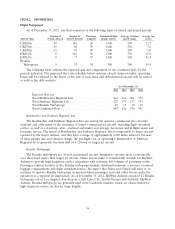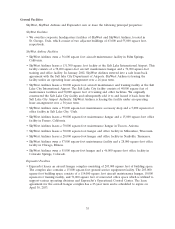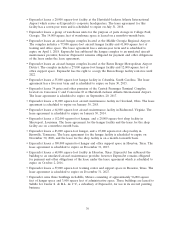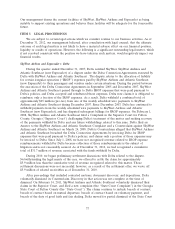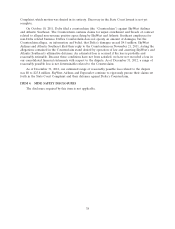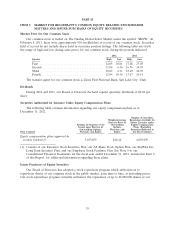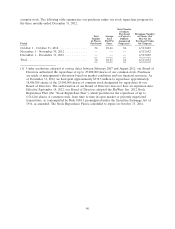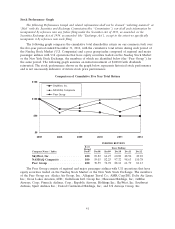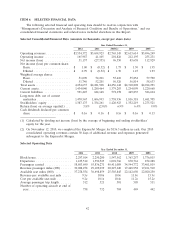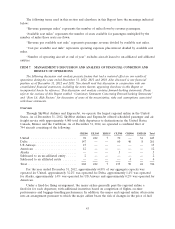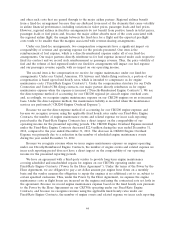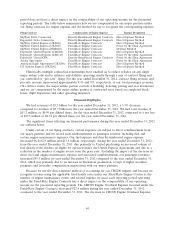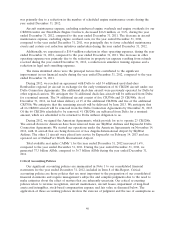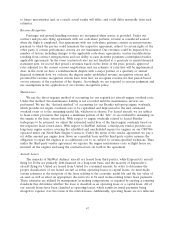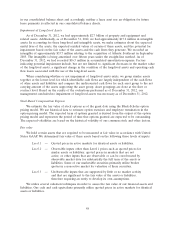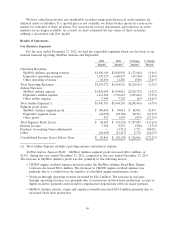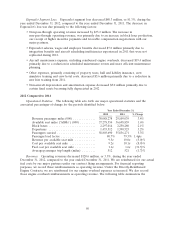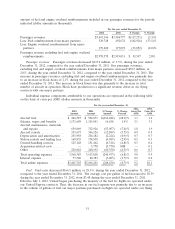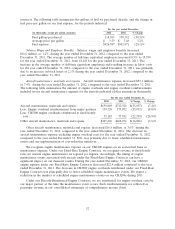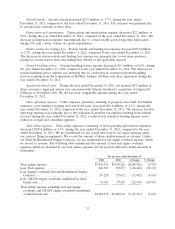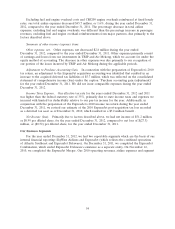SkyWest Airlines 2012 Annual Report Download - page 48
Download and view the complete annual report
Please find page 48 of the 2012 SkyWest Airlines annual report below. You can navigate through the pages in the report by either clicking on the pages listed below, or by using the keyword search tool below to find specific information within the annual report.and other such costs that are passed through to the major airline partner. Regional airlines benefit
from a fixed-fee arrangement because they are sheltered from most of the elements that cause volatility
in airline financial performance, including variations in ticket prices, passenger loads and fuel prices.
However, regional airlines in fixed-fee arrangements do not benefit from positive trends in ticket prices,
passenger loads or fuel prices and, because the major airline absorbs most of the costs associated with
the regional airline flight, the margin between the fixed-fees for a flight and the expected per-flight
costs tends to be smaller than the margins associated with revenue-sharing arrangements.
Under our fixed-fee arrangements, two compensation components have a significant impact on
comparability of revenue and operating expense for the periods presented. One item is the
reimbursement of fuel expense, which is a directly-reimbursed expense under all of our fixed-fee
arrangements. Our major partners directly reimburse us for fuel expense incurred under each respective
fixed fee contract and we record such reimbursement as passenger revenue. Thus, the price volatility of
fuel and the volume of fuel expensed under our fixed-fee arrangements will impact our fuel expense
and our passenger revenue equally, with no impact on our operating income.
The second item is the compensation we receive for engine maintenance under our fixed-fee
arrangements. Under our United, American, US Airways and Alaska flying contracts, a portion of our
compensation is based upon fixed hourly rates, which is intended to compensate us for engine
maintenance costs (‘‘Fixed-Rate Engine Contracts’’). Under the compensation structure for our Delta
Connection and United CPA flying contracts, our major partner directly reimburses us for engine
maintenance expense when the expense is incurred (‘‘Directly-Reimbursed Engine Contracts’’). We use
the direct-expense method of accounting for our CRJ200 regional jet aircraft engine overhaul costs
and, accordingly, we recognize engine maintenance expense on our CRJ200 engines on an as-incurred
basis. Under the direct-expense method, the maintenance liability is recorded when the maintenance
services are performed (‘‘CRJ200 Engine Overhaul Expense’’).
Because we use the direct-expense method of accounting for our CRJ200 engine expense, and
because we recognize revenue using the applicable fixed hourly rates under our Fixed-Rate Engine
Contracts, the number of engine maintenance events and related expense we incur each reporting
period under the Fixed-Rate Engine Contracts has a direct impact on the comparability of our
operating income for the presented reporting periods. The CRJ200 Engine Overhaul Expense incurred
under the Fixed-Rate Engine Contracts decreased $22.4 million during the year ended December 31,
2012, compared to the year ended December 31, 2011. The decrease in CRJ200 Engine Overhaul
Expense was primarily due to a reduction in the number of scheduled engine maintenance events
during the year ended December 31, 2012.
Because we recognize revenue when we incur engine maintenance expense on engines operating
under our Directly-Reimbursed Engine Contracts, the number of engine events and related expense we
incur each reporting period does not have a direct impact on the comparability of our operating
income for the presented reporting periods.
We have an agreement with a third-party vendor to provide long-term engine maintenance
covering scheduled and unscheduled repairs for engines on our CRJ700s operating under our
Fixed-Rate Engine Contracts (‘‘Power by the Hour Agreement’’). Under the terms of the Power by the
Hour Agreement, we are obligated to pay a set dollar amount per engine hour flown on a monthly
basis and the vendor assumes the obligation to repair the engines at no additional cost to us, subject to
certain specified exclusions. Thus, under the Power by the Hour Agreement, we expense the engine
maintenance costs as flight hours are incurred on the engines and using the contractual rate set forth in
the agreement. Because we record engine maintenance expense based on the fixed hourly rate pursuant
to the Power by the Hour Agreement on our CRJ700s operating under our Fixed-Rate Engine
Contracts, and because we recognize revenue using the applicable fixed hourly rates under our
Fixed-Rate Engine Contracts, the number of engine events and related expense we incur each reporting
44


